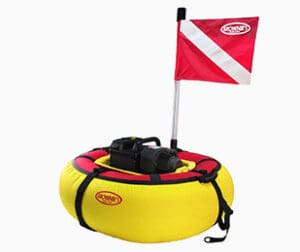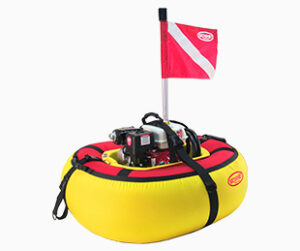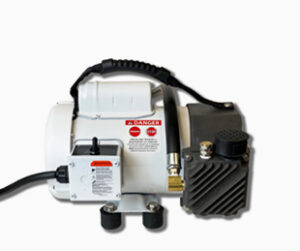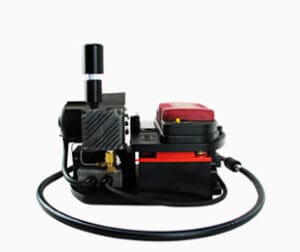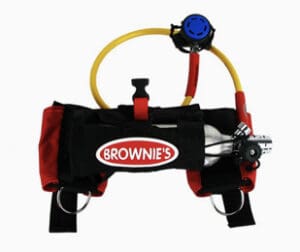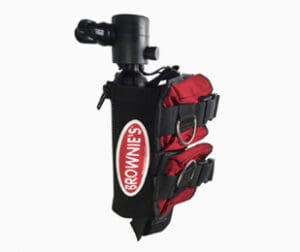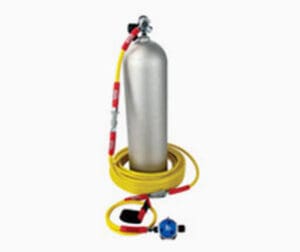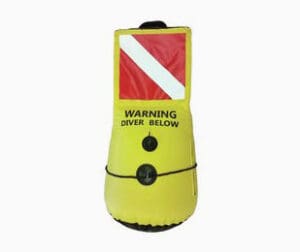The Brownie’s THIRD LUNG™ factory is open Monday – Friday 8:30am – 5pm (EST). If you have any questions regarding a new or used Brownie’s system, please give us a call and chat with our technical staff.
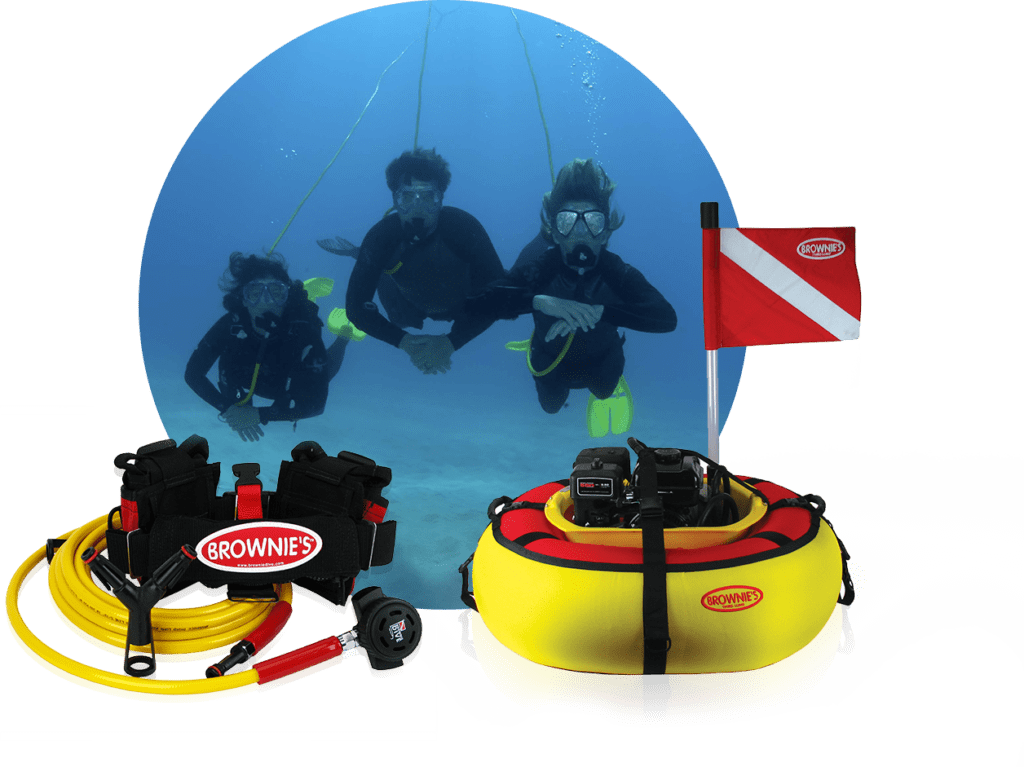
What is the advantage of Direct Drive surface supplied air unit?
In compressor design, simple is better. The Brownie’s THIRD LUNG™ Direct Drive units don’t have belts and pulleys. Fewer components mean even fewer maintenance concerns. More importantly, the Direct Drive compressor can handle high RPM’s and produce more air. Our older compressors had to be stepped down by way of a pulley, as they handled only half the RPM’s that the engine generated. The result is a unit that can provide an extended operating depth for multiple divers.
The Brownie's Pioneer and the Explorer look smiliar. What are the differences?
The Pioneer and the Explorer Direct Drive Third Lungs use only the best HONDA motor but have either a single or dual head Direct Drive system that determines the number of divers allowed and to what depth. The Pioneer is a Single piston system that can support 2 divers from 70-80 feet or 3 divers to around 45 feet (with an Add-A-Diver kit). Its main advantage is that it’s only 48 pounds– about the same weight as a single tank SCUBA rig. If the divers must carry a system over a great distance to get to their entry point, the 285 would be very attractive.
The more active hookah diver would be well advised to select the Explorer. The Explorer is a Double piston system set up for 3 diver to 80 feet and produces enough air for 4 divers to 45 feet. The Explorer only weighs 55 pounds and is the workhorse of the Brownies’ line. It is the perfect selection for the diver looking to get the highest possible performance from a hookah system.
Hookah diving looks like snorkeling. Do I need to be trained?
True, Brownie diving is almost as easy as snorkeling. The freedom of swimming unencumbered by SCUBA tanks will certainly remind you of snorkeling or free diving. Still, whenever you breathe compressed air while under water, you are operating under a different set of rules. Training is required for everyone who uses the Brownie unit.
The training could be a traditional open water SCUBA certification course or a Recreational Hookah Diver course. The latter course was specifically designed for Recreational Surface Supplied Air Diving through the joint efforts of both Brownie’s Third Lung and the National Association of Underwater Instructors (NAUI). Courses involve about 30 contact hours and can be completed in as few as 5 days depending on available scheduling time for both instructor and students. With proper training and proper maintenance of equipment, hookah diving can be extremely safe. Brownie’s Third Lung has been accident free since it’s inception in 1969.
What about diving wrecks or in kelp?
Obviously, your use of a Third Lung to dive in overhead environments will be limited. Only slight penetrations are possible, and they should never be attempted without a back up air source. If you have evaluated a dive site and have been able to determine that a Third Lung is appropriate, you can add additional hose lengths to increase your linear penetration range. Always be aware that hookah diving follows different rules than SCUBA; make certain that your air hose is free from potential entanglement or damage.
The Third Lung’s advantage is that it is easy to find you’re way back out. Just pick up your hose as you exit from the overhead environment. If you use your Third Lung in an overhead environment, you should always carry an alternative air source, such as the Brownie’s Egressor System.
Is it hard to pull a THIRD LUNG™ along the surface while diving?
You might be surprised, but there is less water resistance in towing a THIRD LUNG™ than in swimming with a full set of SCUBA gear. Considering that most Brownie dives are shared between two or three people, swimming with a THIRD LUNG™g is very easy. Conditions can increase the drag; windy days may make towing more noticeable. Many people simply drift dive on days when the wind is a bit strong, allowing the surface unit to gently tow them along through a dive.
Will a Third Lung flip over?
The Brownie’s THIRD LUNG™ rides well on waves and is even built to take a splash. If conditions are suitable for safe recreational diving, the Brownie’s THIRD LUNG™ will handle the waves. Breaking waves near shore, however, are a different concern. A breaking wave in the surf zone or a large wake from a boat could potentially flip the unit, so the user must seek safe operating areas as part of their pre-dive checklist.
If you are diving from shore, a hands-on transfer through the surf is essential. If you are diving from a boat, take special care in placing the Brownie over the boat’s transom and into the water. Lowering the unit straight into the water ensures a safe launch.
What happens if the engine stops?
Seriously, should the compressor develop problems during a dive, the diver might first be alerted of the air disruption when he or she no longer hears the gentle tapping created while the compressor is running. The tapping channels down the hose to the diver. If the divers do not notice the cessation of tapping, breathing becomes restrictive at first, followed by an out of air situation. In either case, the diver must begin an immediate slow ascent to the surface. While free ascents from shallow depths are relatively easy, they are not without risk. Too fast an ascent can result in a pressure injury to a lung. Our recommendation is to have a back up Egressor System for each diver. The Egressor is hardly noticeable and rides in a handy sleeve in the small of the back. It provides a very small back-up SCUBA reserve for emergency situations as well as a quick response to items dropped overboard, verifying anchor location, hull inspection, prop clearing, pool maintenance, and much more!
How long are the hoses?
Brownies hoses run off of the compressor unit in stages. First, a 7-foot heat hose cools the air as it leaves the compressor. Depending on the package you choose, a 30 foot or a 60 foot common hose connects to the heat hose, leading to a split that supplies the 20-foot Diver’s hoses. This system allows the divers to swim apart but keeps them within 40 feet of each other. All hoses use sturdy, reliable Quick Release Swivels that reduce air interruptions caused by hose kinks.
Why do you use a common downline and then give each diver a 20-foot hose? Why not give each diver individual hoses coming from the heat instead?
If that is the way the customer wants it, that’s the way the customer gets it. No arguments. But there is a method to our madness. Not only do our customers prefer a single common hose leading off of the compressor, there’s a solid performance reason behind the design.
More hose does not create better performance. More hose equals more resistance (or work for the compressor), more buoyancy (more lead is required for the divers to wear) and more hose management (just a distraction that gets in the way of your fun). Another key point is that the diver’s stay within 40 feet of each other. We think that it is a lot safer than being able to separate by more than 100 feet.
The single shared hose eliminates these problems. While others might tell you that separate hoses provide better breathing, be wary. We still dive the common hose without ever noticing increased breathing resistance, and we are happier that we have eliminated the hassles that additional hoses create. Here at Brownie’s Third Lung, we can configure the hose on your personal diving system any way you want it– but we’d suggest that you try the single common hose before modifying your Third Lung to use multiple hoses from the compressor.
Why the range?
Because different people breathe at different rates. It would be misleading to state that a system “truly” or “without a doubt” supports a certain number of divers to a definite depth. While we could quote one “best depth” rating, in the real world people breathe at different rates. The mechanics of determining maximum depth are not complicated: the deeper you dive, the less air you get from the compressor. That’s why we use ranges. We want you to know before you buy.
Why can't I use a surface reserve tank attached to the Brownie’s THIRD LUNG™ for emergencies? Do I really need an Egressor System?
While we make bottles that attach to a Third Lung, they are not reserve tanks. Instead, they are accumulators designed for commercial application. A reserve tank is a back up air source, while an accumulator simply allows the diver to work a bit harder at times. Sometimes, with exertion, the diver can over-breathe the compressor’s capability to produce air. The accumulator allows the diver a little extra air for short bursts. The Egressor System, or some other pony bottle/SCUBA backup, is the safest insurance against an out-of-air emergency. The Egressor System’s Drop Weight Cummerbelt fits comfortably around your waist and provides you with both a weighting system and an emergency air source. The Egressor System is the best possible backup for your family during their hookah dives.
Why doesn't the Brownie’s THIRD LUNG™ have an intake filter?
The intake filters that are supplied by the compressor manufacturer are plastic housings with only a piece of felt as the filtering media. They only filter dust, not carbon monoxide, water or carbon dioxide. They do not provide an additional safety margin or relevant benefit for either the diver or the machine while at sea. Also, the intake holes point directly up, where rain and water spray may easily enter. This position allows the felt to become wet or damp and may lead to interior damage to the compressor. The felt filters may also mildew if not changed, posing a potential health risk to the diver.
We take the felt filter housings completely off. We eliminate the dust catcher in favor of a cap that keeps rain and seawater from entering the compressor’s air intake while reducing air intake restriction to a true minimum. The results show with our unmatched performance.
How do you keep the exhaust fumes out of the engine?
Air is taken in high through the remote intake “snorkel/intake staff” The exhaust is low and exits the engine in the opposite direction being towed. The engine fan, designed to cool the block, further creates an air buffer between the exhaust and the intake.
Brownie’s compressors are tested and meet the same grade air (E) required for scuba. Brownie’s Third Lung furthers the detail by adding a DRY snorkel cap to the remote intake.
How much maintenance is required on a THIRD LUNG™?
Everything you need comes with the Care Kit. While the system is running, hose the unit and hoses, etc. down with fresh water, following owner manual instructions. Attach the air gun to the heat hose and dry the Brownie quickly and easily. Next, use Corrosion X to lightly spray the engine (not the compressor). When everything has dried, store your unit in a cool dry place. You may put Stabil in the fuel tank for short-term storage, but for long-term storage you must drain the gas out of the tank as well as the carburetor. The regulators should be serviced yearly by any full service dive shop. Follow the Honda owner’s manual for maintenance requirements for the engine.
I've heard that only a few compressors are designed for diving and that most are for construction purposes. Is your compressor designed for construction or diving?
Actually, neither statement is true. The manufacturers of oil-less compressors do not have a specific design for diving or for construction. How the oil-less compressor is utilized varies, just like any other light engine. For instance, a gasoline engine might be used to run a lawn mower, a go-cart, or in our case a Surface Supplied Air diving system. It’s still the same engine. The same is true of the oil-less compressor. All of our oil-less compressors are then married to “air breathing quality” materials such as your fresh air intake and hoses. When your compressor heats up, any components that are not of air breathing quality can possibly give off gas toxic fumes that can make a diver ill. Brownie’s takes all components used with our Hookah systems and ensures all components are of air breathing quality.
Why do you use plastic swivel fittings instead of metal fittings? Won't these break?
The metal fitting’s swivel capabilities are limited at best. We used them for years until we developed the plastic/delrin particle filled Quick Release Swivel fittings. These QRS fittings are sturdy, will not accidentally disconnect and reduce kinks with their swivel action. The plastic fittings have several additional benefits over metal fittings. Metal fittings will oxidize quickly in the marine environment. Brownie’s Third Lung QRS fittings will provide years of trouble-free use. While it is possible to break a QRS fitting, they are inexpensive and can be replaced easily with a wrench. Metal fittings can bend, making it impossible to fix yourself, especially if out at sea.
I'm concerned about room on my boat. How much space and weight does a Third Lung take up when stored?
All of our THIRD LUNG™ units take up much less than the equivalent weight and space required for two SCUBA divers planning two dives. The storage case is 24″L x 18″D x 20″H and a gear bag is 31″L x 14″ diameter. The 285 weighs only 48 pounds, and the Explorer weighs only 58 pounds. With such compact dimensions, your Brownie’s THIRD LUNG™ can easily stow on any size boat.
Flipped My Unit!
OH NO – your unit just flipped! Don’t panic! Here is a list of proper steps that can get your system back into operation and you back into the water. Please click on the link to read the steps to follow. Link: Flipped my Unit
Join Brownie’s THIRD LUNG™ Newsletter for Exclusive News & Deals
Sign up to receive the latest deals and news.

